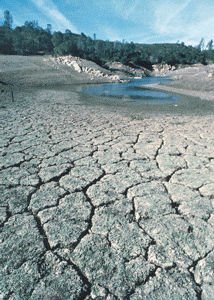Organic farmers in California face unique issues in this devastating drought, leading some to bow out … or sell cows for hamburger meat.
Food & Environment Reporting Network
By Kristina Johnson
 |
San Joaquin Valley organic dairy farmer Tony Azevedo’s business has dried up—literally. Because of the record-breaking California drought, he has nothing to feed his cows except what he has stored, and he expects that will be gone in about 100 days. “It’s a desert out here,” he says.
With their pastures barren, organic cattle and dairy farmers in California are either spending thousands of dollars to truck in supplemental organic feed from states as far away as Arizona, or like Azevedo, looking at bowing out of farming altogether. In some cases, operating costs have tripled. Last weekend’s storm, which dropped as much as 4 inches of rain in the Bay Area, still won’t be enough to alleviate the worst drought since the state started keeping records in 1849.
So will organic food prices jump in response?
“Right now supplies are steady,” says Louise Hamstead, Chief Operating Officer at Organic Valley, a cooperative that is the nation’s third largest buyer of organic milk. “But that could change once temperatures start to rise.”
If the drought persists, consumers in California may find shortages of organic milk at the grocery store, Hamstead said. In 2011, California farmers made $127.2 million on organic milk sales, according to the most recent USDA figures.
Organic livestock farmers are in a unique bind in this drought, because to qualify as organic meat or milk under USDA regulations, their cows must only eat organically produced feed. At the same time, they must graze their animals on pasture at least 120 days a year—a requirement absent in conventional dairy operations.
With pastures drying up and organic feed costs skyrocketing, organic farmers in California are facing tough choices in feeding their animals.
Many organic ranchers in the Golden State raise their animals entirely on grass, producing 100% grass-fed beef. When the USDA last checked in 2011, there were 545,883 acres of organic pasture and rangeland in the state, but this year, with those pastures dry, organic livestock are consuming about 90% hay—at a steep cost.
Even under normal conditions, organic hay is more expensive and often hard to find. With grain growers across the United States planting corn for ethanol, instead of hay for animals, supplies were already short. Add in several years of poor harvests from low rainfall across the West, and you have what Mark Kastel, co-founder of the Cornucopia Institute, a sustainable agriculture advocacy group, calls “a perfect drought.”
“An ever increasing number of organic farmers are going after a decreasing supply of hay,” Kastel says. “This is a drought in rain and a drought in feed.”
Darrel Wood of the organic grass-fed beef company, Panorama Meats, in Vina, California, said he recently ordered a truckload of organic hay from Montana to his ranch in the Sacramento Valley, 1,000 miles away. It was the closest shipment he could find. He’ll write a check for $350 per ton when it arrives, instead of the $200-$250 a ton it cost last year.
“I wake up every morning wondering where I’m going to find two or three truckloads,” Wood says of his search for hay. “I don’t want to say it can’t get worse, because it can, but it’s tough right now.”
Wood’s afraid he’ll have to raise the price of his meat by 20% to cover the difference. Even then, he doesn’t expect to make any money this season.
Clint Victorine, owner of Eel River Organic Beef, the second largest grass-fed beef operation in the country, based in Humboldt County, said that before the drought, it cost about 60 cents in feed and labor to produce a pound of meat. Today, those costs have doubled. He’ll try and make some of that back by raising his organic meat prices 8%.
In response to these drought conditions, organic farmers are seeking a variance in USDA’s pasture requirements for organic cows. In past droughts, the USDA’s National Organic Program has temporarily lowered the minimum number of days an animal has to spend on pasture and cut the required amount of dry matter, or nutrition, in their diet from fresh forage. To some degree, a variance would help California producers—who manage 13.2% of the country’s organic livestock — to preserve their organic certification.
“Two California based certifying agents have requested variance from pasture requirements due to the severe drought,” said Miles McEvoy, deputy administrator for the National Organic Program, in an e-mail. He said the USDA’s Agricultural Marketing Service “expects to issue a decision in the near future.”
Despite ranchers and dairy owners buckling under high feed costs, a USDA spokesperson doesn’t think consumers will feel the effects of California’s drought on their wallets. The impact on organic food prices will be “relatively small,” the agency rep predicts.
Kastel of the Cornucopia Institute agrees.
“Farmers are price takers, not price makers,” Kastel says. He believes farms will go under well before consumers have to pay more for organic milk or meat. This may be especially true in the organic dairy industry, where few producers sell under their own label and thus have no control over their selling price.
Most organic dairy farmers in California sell to three main buyers—White Wave Foods’ Horizon Organic, Aurora Organic Dairy and Organic Valley—all of whom compete with one another. “We’ll have to see which one cries uncle first with this drought and raises prices,” Kastel says. Until one of them does, profit margins will continue to shrink for dairy farmers as costs rise.
In response, organic farmers are liquidating their herds. Independently-owned dairies like Doug Beretta’s in Sonoma are selling their cows for hamburger meat or as milk cows to large conventional operations in the central part of the state. “Some of the big dairies have enough of a war chest stored up that they can beat the smaller guys to all the feed. They have enough money that they can keep growing even in a year like this,” he says.
The national beef herd size is already at a 61-year low after several years of drought and extreme cold in different parts of the country. Beef supplies are tight and prices at record heights.
But at Panorama Meats, Wood is pressing ahead and hopes his customers will understand a 20% price hike: “Every pound of ground beef and every steak they purchase keeps a family ranch in business,” he said.
This article was originally published on Medium.com and was produced by the Food & Environment Reporting Network, an independent, nonprofit news organization producing investigative reporting on food, agriculture, and environmental health.
On February 12, the USDA granted a temporary pasture variance for California organic farmers.

